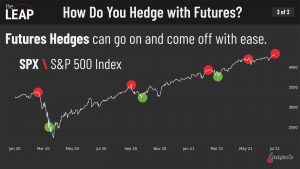How to Hedge Using Futures
Hedging can be conducted at the position level and portfolio level (or both), and one potential vehicle for such protective hedges are futures, which cover a wide spectrum of products/sectors.

In the trading world, hedging is a method of reducing risk in the portfolio. Hedging can be conducted at the position level, the portfolio level, or both.
The intent of a hedge is to reduce the risk in a single position, or to reduce risk in a group of other positions.
For example, consider an investor holding a portfolio dominated by long equity exposure (e.g. traditional “buy and hold” approach). Investors carrying this type of portfolio exposure sometimes look to short index futures, when fear creeps into the financial markets.
Along those lines, imagine a trader holding a portfolio dominated by short premium in options (i.e. short volatility). Traders holding an overall portfolio such as this often maintain a short stock market index hedge to protect against a correction.
This is done because corrections are usually characterized by increases in volatility, which would theoretically impair a short volatility portfolio. In this capacity, a short stock market index hedge produces a profit during a correction, which can in turn help offset losses in the short volatility portfolio.

The futures marketplace was actually first developed because of the need for hedging. For example, a farmer in Iowa might be expecting a bumper crop of soybeans in a volatile price environment. In order to reduce price volatility (and anxiety) at harvest time, the farmer might choose to sell all or part of the expected soybean harvest using futures.
In this regard, the farmer has “hedged” some (or all) of the price risk associated with the future harvest. One can see how other participants in the physical commodities market might use hedging in a similar manner—gold miners, crude oil explorers and steel producers.
Futures, which cover a wide range of financial instruments (stock indices, commodities, currencies) are therefore ideally suited for hedging. And for retail traders, the Small Exchange is especially well suited for portfolio hedging, because futures contracts on the Small Exchange offer lower notional values as compared to traditional futures. That means less capital is tied up when trading the Smalls.
Likewise, the Smalls also offer an innovative suite of products, including: stock market index, precious metals, interest rates and foreign currencies, among others.
As outlined below, each of the Smalls can be used to hedge, or manage risk, according to the unique needs of each market participant:
- Small Stocks 75 Index (SM75): Traders seeking to hedge risk exposure in the U.S. equity markets can consider utilizing the Small Stocks 75 Index. The index is comprised of five equally-weighted market sectors with 15 stocks in each (75 total stocks). The SM75 shares a roughly 0.83 positive correlation with the S&P 500, and has a contract size about 1/30th the size of the E-mini S&P 500. The Small Stocks 75 Index exhibits on average about 30% greater volatility than the S&P 500. It is also considerably more capital efficient when compared to trading the SPY (S&P 500 ETF). Trading one contract in the SM75 requires about 93% less capital as compared to trading its equivalent in the SPY (roughly 20 shares at today’s prices).
- Small 10-Year U.S. Treasury Yield Index (S10Y): The Small 10-Year U.S. Treasury Yield Index simplifies interest rate trading by allowing market participants to directly trade the U.S. 10-Year Treasury Yield, instead of trading Treasury Bond futures—the latter being the traditional method of accessing exposure to movement in interest rates. The S10Y can therefore be utilized to hedge or risk manage other interest-rate sensitive positions in a given portfolio. Like the SM75, the S10Y also offers attractive margining when compared to a similar product in the ETF universe. A single S10Y contract is equal to about 40 shares of TLT (iShares 20+ Year Treasury Bond ETF), and a single S10Y contract requires roughly 96% less margin than those 40 shares of TLT. It should be noted that the S10Y and TLT are strongly, negatively correlated (-0.95). That means traders seeking to replicate a long TLT position would sell S10Y, and traders seeking to replicate a short TLT position would buy S10Y.
- Small Precious Metals Index (SPRE): The Small Precious Metals Index is comprised of a price-weighted combination of gold, silver and platinum. Each metal’s weight in the index is calculated through a unique combination of global production, domestic consumption, and dollar-denominated volume. Market participants can therefore use SPRE to hedge positional or portfolio exposure to precious metals. SPRE has exhibited on average a positive correlation of 0.93 with GLD (SPDR Gold Shares) and 0.91 with SLV (iShares Silver Trust). A single contract in SPRE is equivalent to roughly 60 shares of GLD and 300 shares of SLV, which translates to about 95% less in margin when compared to GLD and SLV.
- Small Dollar Index (SFX): The Small Dollar Index is a combination of Euro, Chinese Renminbi, Japanese Yen, British Pound, Canadian Dollar, Australian Dollar and Mexican Peso. Weights are determined through the associated region’s gross domestic product and dollar-denominated trade volume. Market participants can use the SFX to hedge or risk manage positional or portfolio currency exposure. The SFX has exhibited an average positive historical correlation of 0.85 with UUP (Invesco DB US Dollar Index Trust) and an average historical correlation of -0.88 with the FXE (CurrencyShares Euro Trust). A single contract in SFX is equivalent to roughly 500 shares of UUP, and 200 shares of FXE, which translates to about 98% less margin when compared to UUP or FXE.
To learn more about hedging with futures, readers are encouraged to review this new installment of Small Stakes on the tastytrade financial network, which walks viewers through a real-life example using a hypothetical position in the precious metals sector.
More information on hedging with futures is also available via this link.
To follow everything moving the financial markets in 2022, readers can also tune into TASTYTRADE LIVE—weekdays from 7 a.m. to 4 p.m. CST—at their convenience.
Sage Anderson is a pseudonym. He’s an experienced trader of equity derivatives and has managed volatility-based portfolios as a former prop trading firm employee. He’s not an employee of Luckbox, tastytrade or any affiliated companies. Readers can direct questions about this blog or other trading-related subjects, to support@luckboxmagazine.com.



















